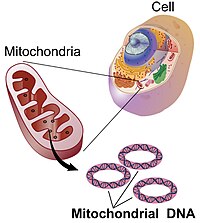
Photo from wikipedia
RESEARCH QUESTION Conflicting data exist on the utility of quantification of mitochondrial DNA (mtDNA) levels as a predictor of blastocyst implantation in the IVF clinic. The current study determined whether… Click to show full abstract
RESEARCH QUESTION Conflicting data exist on the utility of quantification of mitochondrial DNA (mtDNA) levels as a predictor of blastocyst implantation in the IVF clinic. The current study determined whether blastocysts with highly elevated mtDNA levels could result in healthy pregnancies and births, and whether mitochondrial functional output might be a readout of cell stress in the embryo. DESIGN mtDNA levels were determined in 109 blastocysts used in clinical transfers into 100 women, noting their clinical outcomes. In a separate set of embryos, mitochondrial function was quantified in a model of embryo stress, aneuploidy. Measurement of mtDNA levels made use of surplus material from the process of preimplantation genetic testing for aneuploidies, and followed recently proposed unifying guidelines for mtDNA quantification. RESULTS Unusually high mtDNA levels did not preclude blastocyst implantation and healthy births. An analysis of 109 blastocysts showed no significant difference between mtDNA levels in implanted (n = 55) versus non-implanted (n = 54) blastocysts. No obvious differences in the degree of mitochondrial functional output were detected in a model of embryo stress. CONCLUSIONS Measurement of mtDNA copy number might not provide any advantage in embryo prioritization and could lead to a deselection of blastocysts that would result in healthy pregnancies and births. Furthermore, the quantification of mitochondrial functional output in a model of cellular stress might suggest that mitochondria are not clear targets for biomarker identification as it relates to blastocyst viability. Any suggested link between mtDNA levels, mitochondria or their output with blastocyst transfer outcome requires further validation.
Journal Title: Reproductive biomedicine online
Year Published: 2019
Link to full text (if available)
Share on Social Media: Sign Up to like & get
recommendations!